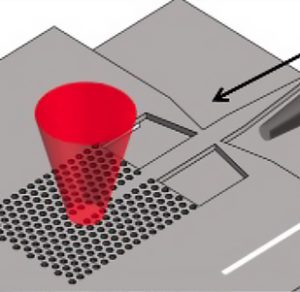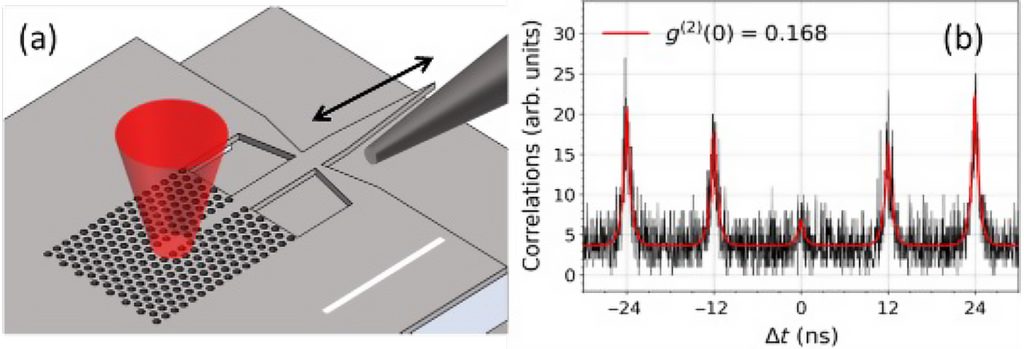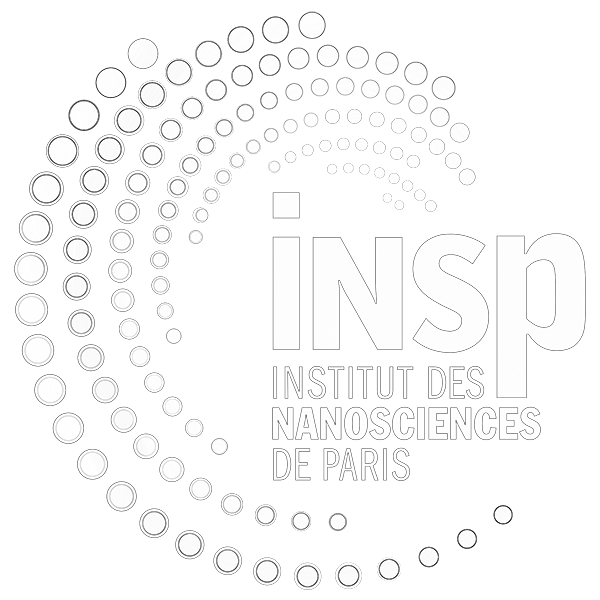Collecting single photons using adiabatic coupling between waveguide and optical fiber
 Semiconductor-based quantum dots have demonstrated remarkable potential for quantum information applications, such as the bright emission of single and indistinguishable photons or the creation of qubits that can be initialized, manipulated, and read using light pulses. Many challenges remain to be overcome in order to make their use robust and to create platforms where multiple qubits can be addressed and entangled with each other. To this end, several approaches have been proposed in the literature, including introducing emitters into photonic cavities to increase light-matter interaction and coupling the nanostructures to photonic waveguides for efficient photon extraction. Researchers at INSP, in collaboration with colleagues from C2N, have shown that photons emitted by quantum dots (QDs) inserted into photonic crystal cavities and coupled to waveguides can be collected in the plane by a conical optical fiber, thanks to evanescent mode coupling between the guide and the fiber.
Semiconductor-based quantum dots have demonstrated remarkable potential for quantum information applications, such as the bright emission of single and indistinguishable photons or the creation of qubits that can be initialized, manipulated, and read using light pulses. Many challenges remain to be overcome in order to make their use robust and to create platforms where multiple qubits can be addressed and entangled with each other. To this end, several approaches have been proposed in the literature, including introducing emitters into photonic cavities to increase light-matter interaction and coupling the nanostructures to photonic waveguides for efficient photon extraction. Researchers at INSP, in collaboration with colleagues from C2N, have shown that photons emitted by quantum dots (QDs) inserted into photonic crystal cavities and coupled to waveguides can be collected in the plane by a conical optical fiber, thanks to evanescent mode coupling between the guide and the fiber.
The photonic crystal cavities, known as L3, are created by ICP etching around the QDs (Figure 1-a) for better spatial matching. To this end, the luminescence of the quantum dots is first mapped in order to determine their position, which is random on the surface following epitaxial growth. The parameters of the photonic crystal are calculated to best match the cavity mode to the emission wavelength of the QD. These two aspects – spatial and mode matching – are crucial for achieving good coupling with light. The cavity is coupled to a photonic crystal waveguide, resulting in a conical GaAs waveguide, whose mode can be coupled evanescently to the stretched fiber we have engineered. In the realized structures, the theoretical coupling rate is 60%, a value obtained for an interaction length of 2.5 µm.

Figure 1 (a) SEM image of the realized nanostructure at C2N. A cavity coupled to a photonic crystal waveguide (PCWG) ending in a triangular GaAs waveguide is coupled in-plane to a stretched optical fiber (b).
Lifetime measurements allowed the Purcell factor to be estimated, a figure of merit that characterizes how the cavity accelerates photon emission. The efficiency of the in-plane collection was estimated by measuring the intensities of the collected luminescence, on the one hand, by a microscope objective above the membrane and, on the other hand, by the optical fiber in the plane (Figure 2-c). Collection by the fiber is increased by a factor of 5 thanks to waveguide-optical fiber coupling, which is only 2.5 times lower than the predicted theoretical value. To further characterize the emission properties of QDs, photon correlation measurements showed that photon unicity was at least 83%.

Figure 2 (a) Sketch of paths of excitation through a microscope objective placed above the membrane (red cone) and luminescence collection by the fiber inside the cryostat. The arrow indicates the length of interaction between the fiber and the guide. (b) Measurement of photon correlations showing that the unicity of photons is 83%, slightly degraded by high-power excitation.
Performing photon correlation measurements under resonant excitation will improve the purity of the single-photon source and is the next step in demonstrating bright single-photon emission coupled to off-chip optical fibers.
Better spatial and spectral matching of the emitter with the photonic cavity will increase the fraction of photons emitted by the QD coupled to the photonic crystal cavity mode and channelled into the photonic crystal waveguide. Finally, a theoretical adiabatic coupling efficiency close to unity between the conical GaAs waveguide and a stretched optical fiber is predicted if the coupling length between these two elements is increased from 2.5 μm in our case to 5 μm. Such coupling efficiency is very interesting for the realization of single-photon sources coupled to an optical fiber for applications.
Reference
“Collecting single photons from a cavity-coupled quantum dot using an adiabatic tapered fiber“
Bach, A. Chapuis, C. Morin, R. Hostein, S. Germanis, B. Eble, M. Bernard, F. Margaillan, P. Atkinson, and V. Voliotis, K. Moratis, R. Braive
PHYSICAL REVIEW APPLIED 23, 044008 (2025)
Contact
voliotis(at)insp.jussieu.fr

